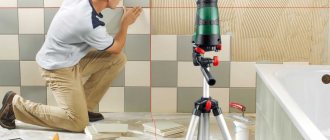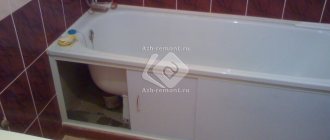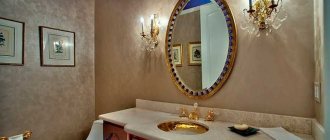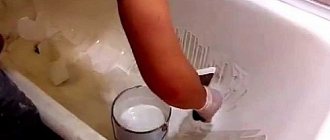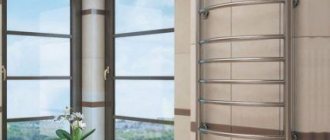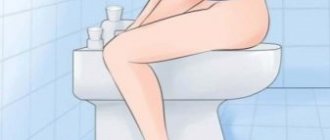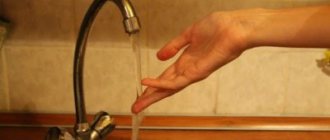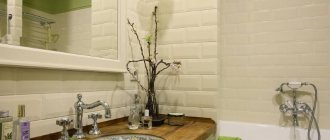Condensate is a product that is formed when water changes from gaseous to liquid form. The amount of moisture in the air is determined by the temperature of the room. The warmer the air temperature, the greater the amount of water vapor it can hold. When temperatures drop to a certain level, moisture from the air turns into a liquid state, dew or condensation occurs.
There is a temperature value that is called the “dew point”. This is an indicator of the maximum saturation of air with moisture at a constant temperature. When warm air comes into contact with a cool surface, a physical phenomenon occurs - condensation.
Condensation occurs in all rooms with high relative humidity. In apartments, bathrooms, toilets, kitchens, basements with heating pipes, and balconies suffer from this phenomenon. Dew falls on the tiles, water and sewer pipes, the cistern, and condensation appears on the windows. This harms functional structures; humidity has a destructive effect on metal products and connecting elements.
Where does humidity come from in the bathroom?
This parameter depends on many factors:
- Time of year (humidity is higher in summer)
- Weather conditions outside (rain, fog)
- Living activities of residents (washing, cleaning, washing, drying wet things, cooking)
- Heating system efficiency
- Room ventilation
- Ventilation operation
- Window tightness
- Quality of finishing materials
Moisture on tiles
Often dampness depends on the floor of the apartment . Living on the ground floor is almost always associated with greater dampness than on higher floors. Dampness can “stretch” from the basement of a room due to such a physical phenomenon as capillary suction of moisture (from the soil through the foundation) along the walls. In addition, if trees or shrubs grow densely under the windows, they create additional humidity in the surrounding air . We all know the damp smell in the forest, in the park, in the country. In addition, trees interfere with ventilation. They can outshine the sun. And without direct sunlight, the room dries worse.
The bathroom is always damp from water treatments. The shower itself creates this environment. In addition, after washing, few people wipe the surface of the bathtub. The drops of water will, of course, dry themselves. But this moisture will hang in the air of the room . Water splashes often fall on walls, floors, and nearby objects. Wet rugs and towels are dried there.
Sometimes plumbing leaks add fuel to the fire (figuratively speaking). Dripping water from a tap, leaks or puddles under the bathtub, or a leaking toilet increase the water content in the surrounding atmosphere .
Traditional methods
In some cases, the use of special products is not possible, as they can damage the finishing material. It is worth considering that folk remedies only help when minor black spots appear. Effective folk methods include:
- Creosote, which is produced by using tar. This substance has been used for many decades to treat wooden sleepers, which ensures their service in the open air for a long period. Creosote is diluted using ethers or alcohol-containing substances. Creosote contains substances that can be harmful to human health. Therefore, after using the substance, it is recommended to rinse it thoroughly.
- Ordinary vinegar can also partially solve the problem of removing fungal growths. Natural products are used in its production, which ensures that the substance is environmentally friendly. The only drawback of vinegar is its unpleasant smell. Vinegar can be applied to the surface using a regular sprayer. After spraying it, it is recommended to mechanically treat the surface and rinse everything off with water.
You can clean the surface by using other substances that may be found in the kitchen. Examples include baking soda, alcohol, essential oils, chlorine, laundry bleach, and so on.
In conclusion, we note that folk remedies are used only if other methods of combating fungal formations are taken. Otherwise, some time after surface treatment, black mold may appear in another place.
What is the normal humidity level for a bathroom?
GOST 30494-2011 establishes two types of humidity in residential premises: permissible and optimal. Permissible humidity in winter is 60%, and optimal is 35-40%. This parameter is not set in the kitchen, toilet, and bath areas. When the level rises above 70%, condensation occurs and the presence of dampness in the air is felt. A person's breathing becomes difficult under such conditions. Your health may worsen . Perspiration occurs on the skin even with little physical activity.
To determine the level of humidity in a room, special devices are used - moisture meters (hygrometers). There are several varieties of them:
- Hair device
- Film moisture meter
- Condensation meter
- Weight hygrometer
- Mechanical meter
- Electronic (room) hygrometer
However, a person can feel excessive dampness without special technical means. Often, higher moisture content in the air is accompanied by a characteristic musty smell.
Operating principle of the air handling unit
Exhaust ventilation allows you to control the humidity of the room, create the most comfortable microclimate in the room and ensure continuous circulation of air flow.
Air handling units (AHUs) are used to ventilate huge halls, shopping and entertainment centers, social facilities, and industrial premises. There are compact installations designed for apartments and rooms.
We recommend the product
Air handling unit Vents VUT 180 P5B EC A21
In stock
Minimum temperature of transported air, °C: -25 | Depth, mm: 600 | Height, mm: 302 | Width, mm: 900 | Maximum pressure, Pa: 280 | Noise level, dB: 33 | Air consumption, m³/hour: 220 |
Why is humidity in the bathroom dangerous?
Mold is formed from excessive humidity.
Moisture and heat are suitable conditions for the development of microorganisms. Including harmful and hazardous to health. “Wet” air can contribute to the occurrence of such phenomena as :
- General malaise
- Runny nose
- Digestive disorders
- Bronchial diseases
- Headache
- Nausea
- Skin problems (dermatitis, allergies, cracks)
Children and the elderly are at risk. Children breathe more often. And newborns have weaker immunity than adults. The immune system is also at risk in older people. Chronic diseases may worsen.
High water content in the atmosphere of an apartment can have a detrimental effect on the health of pets . Especially those who live naturally in arid climates. Some types of flowers wither, “get sick” or die if the conditions of maintenance are violated. Including insufficient “dryness” in the room.
Damage to the premises
Excessive air humidity harms the materials used to decorate the room.
Furniture (cabinets, shelves, stands) made of wood or chipboard can swell, crack, and become deformed. Although bathroom furniture is coated with special moisture-resistant paints, it still becomes unusable from constant prolonged exposure to dampness.
Dampness promotes peeling of plaster . Promotes rapid deterioration of paintwork on walls and ceilings.
Parasites, insects
Silverfish love dark and damp rooms.
Parasites, insects and other creatures that are unpleasant to humans love moist habitats. Most pests or parasites usually appear in the bathroom or kitchen.
In addition to being an unpleasant neighborhood and unaesthetic appearance, such guests can be carriers of infections . Often the appearance of a snow-white bathtub or sink is spoiled by excrement. They can spread to other rooms if left unchecked.
The most common uninvited guests are silverfish, woodlice, cockroaches, centipedes, house flies, midges, and flycatchers. The list doesn't end there.
Mold
Mold is the most insidious enemy of any room or apartment . Appears as spots or dots of black, dirty yellow or dirty green. It forms most often in corners, on walls, on ceilings, between tile seams, and in the area of cracks. Mold is often invisible under finishing materials. But when it comes out, there is a need to eliminate and repair it .
Toxins and spores released by mold spread throughout the apartment through the air. By inhaling them, a person puts his health at risk. The effects of mold on humans can include:
- Bad feeling
- Intestinal disorders
- Weakening of the immune system
- Exacerbation of chronic diseases
- Upper respiratory tract diseases
- Allergy
A large amount of mold in a room creates a putrid odor.
Additional ventilation
Standard ventilation systems do not cope particularly well with excess moisture in bathrooms, eliminating only unpleasant odors. To check the draft, just hold a lit match to the ventilation grille and watch how the flame bends. Weak movement indicates the need to take urgent action.
Due to high humidity, silverfish, woodlice, millipedes and other harmless but unpleasant insects may appear in the bathroom.
One solution to the problem could be natural ventilation in the form of additional holes at the bottom of the door leading to the bathroom. A more effective way is to install a small but powerful fan with a switch in the form of a cord, key or dimmer.
Methods for dealing with moisture
Eliminating excess moisture in a bathroom or toilet requires an integrated approach. Often, financial investments are needed to eliminate the cause. But in order to avoid harm to health and not to do frequent renovations in the bathroom, it is advisable to think through a strategy for dealing with moisture in advance.
Forced ventilation
Forced ventilation
Usually the bathroom is equipped with a standard ventilation system. Which, unfortunately, is sometimes not enough for the necessary air circulation. Often the ventilation shaft is blocked by debris. Or “enterprising” neighbors, in the process of renovating the apartment, disrupted its functioning.
To eliminate this problem , there is a technical solution such as forced ventilation . This is an exhaust fan that is installed on the ventilation opening in the wall. The fan is connected to the network. It can be turned on and off as needed.
Warm floor
evaporate excess water from the floor using heated floors . It is better to make such a floor right away, during the renovation of the bathroom. These are special cables or heating mats that are laid as required under the tiles on the floor. These elements are waterproof in case of water leaks. Safe to use. The regulator (switch) is usually connected to the next room. If necessary, home owners can turn it on and regulate the floor temperature.
Ventilation
A method that does not require investment. Just open the bathroom doors and let the room ventilate naturally . Disadvantages of this method:
- An open door into the corridor may interfere with the passage of residents
- Residents may forget to close the door after taking a shower/bath.
- Pets or children will have access to the bathroom (so all household chemicals must be hidden)
Bathroom window
Ordinary apartments rarely have such an “attraction” as a window in the bathroom/toilet. It is almost impossible to do it yourself in an apartment. It is better to consider the possibility of installing a window at the renovation planning stage. It won’t be possible to break down a solid wall, but you can make a window from the bathtub into the kitchen . Or at the time of drawing up a drawing of a future private house, cottage, put a window opening in it. The window will provide an opportunity to ventilate the bathroom naturally . Direct sunlight from the street will create uncomfortable conditions for parasites. They will most likely never start in such a room.
Drying clothes in another room
Drying clothes on lines over the bathtub is a bad idea. Although it has its advantages. Water from poorly wrung clothes will drip directly into the bathtub. Linen will not be visible. But this drying method has more disadvantages, because... This process increases the concentration of moisture in the air . It is recommended to dry washed clothes either on the balcony or in a room near a heating radiator or an open window. There are floor dryers for this.
Elimination of leaking pipes and taps
Check all connections, taps, hoses for leaks. Don't be lazy, look under the bathroom . Perhaps there is a puddle hidden there from your eyes. Check the toilet. Especially the place where it connects to the sewer pipe. It is recommended to keep the toilet lid closed. So that there is also no evaporation of moisture from there.
Technical means
There are dehumidifiers designed specifically for domestic use . Installed in a room where you need to get rid of excess dampness. Available in various versions. There are wall and floor dehumidifiers. They vary in size, noise, and performance. Based on the operating principle, they are divided into adsorbent, condensation and Pelte technology. This is a broad topic that we will not delve into in this article.
However, the high cost of dehumidifiers often push apartment residents to use simpler devices. For example, bring a room fan to the room you want to dry. The fan creates air currents, moisture evaporates faster from surfaces. And instead of a warm floor, a regular heater will do. By raising the air temperature, it helps dry the bathroom quickly. There are heaters with fans. Directed warm air from them will quickly dry the damp corners of the room.
Household air conditioners have the property of not only cooling (or heating) the air, but also drying it. It is not without reason that it is recommended to turn on the air conditioning to remove fogging from your car windows. The operating principle of home and car air conditioners is the same. But, you must admit, it is extremely rare to find “conder” in the shower. The method is more suitable, for example, for the kitchen.
Fighting dampness
To reduce the formation of water vapor with its subsequent condensation into water droplets, it is necessary to organize good ventilation of the internal space. Modern technological solutions make it possible to create high tightness of windows and doorways, and organize high-level thermal insulation. For a healthy microclimate in residential and non-residential premises, it is important to take care of air conditioning and ventilation.
Each room has a system of organized natural ventilation, which is implemented through channels and air ducts installed during the construction of the premises. Additionally, thanks to the installed fans, air flows are forced upward, removed from the apartment and air masses circulate.
Natural ventilation does not cope well with high humidity in bathrooms and kitchens. Loggias, rooms without windows, and basement rooms need additional ventilation.
We recommend the product Exhaust fan Helios MiniVent M1/100 5 reviews
In stock
Finish: matte | Fan noise level, dB: 25, 30 | Air consumption, m³/hour: 75, 90 | Diameter, mm: 100 |
Common mistakes in dealing with excess humidity
- Apartment owners rely on ventilation. But weak air draft may not cope with high levels of humidity.
- Incorrectly installed forced ventilation system.
- Leaks in the water supply system, at the connections of plumbing equipment, and faulty faucets have not been eliminated.
- Poorly chosen finishing materials coupled with a lack of waterproofing of the room. As a result, the walls, ceiling, and floor absorb moisture. Over time they give it away.
- Cracks, holes or poor seals between the walls and sides of the bathtub. As a result, drops of water accumulate behind the bathtub or under it.
- The small size or ineffective operation of the heated towel rail prevents it from drying wet towels. Towels release moisture into the surrounding air.
- The bathroom or toilet is never ventilated.
- The bath mat is never or rarely dried
- The walls and floors of apartments on low floors absorb moisture from the soil through the foundation. The walls release this moisture into the atmosphere.
Antiseptics
The ability to resist fungi and bacteria is another useful property, in addition to moisture resistance, that materials and objects for the bathroom should have: for example, stainless steel and plastic are unattractive to infection on their own. Many paints and tile grouts have antiseptic properties - choose them. Areas of the floor, ceiling and walls that are especially susceptible to infection, as well as the inside of the shower stall, can be treated with a special antiseptic composition.
Causes of mold
To successfully eliminate the problem, you must initially determine the cause in order to eradicate it in the future. Fungus in the bathroom can appear for various reasons, but the main one is invariably increased temperature and humidity. This suggests the importance of increased ventilation. In addition, mold can be caused by the following factors:
- lack of high-quality (or any) waterproofing between walls, wet soil and foundation;
- the content of hygroscopic salts in the material used for the manufacture of walls, foundations or interior finishing works;
- unconsciously creating suitable conditions for condensation of water vapor from the bathroom air.
In the process of combating high levels of humidity, it is necessary, accordingly, to take care of eliminating the above-mentioned causes and factors that can lead to the formation of fungus.
Method 2 – Clean the bathroom
- Take baking soda, lemon juice and vinegar. To remove most of the bad odor from your toilet, you need to give the area around the toilet a good cleaning. Mix lemon juice and baking soda to a paste consistency. Apply this paste to your toilet in the most dirty areas. Wait 10-15 minutes. Next, put the vinegar in a spray bottle and spray the vinegar around the toilet and onto the now dry paste. Wait a little and then remove everything with a damp cloth.
- Add essential oils to cleaning products. When you clean your bathtub or toilet using various chemicals, add a couple of drops of essential oil to it. Some oils, such as cedarwood, have antifungal properties. This will also help remove unpleasant odors and fill the room with a pleasant one.
- Some people neglect to wash the toilet tank when cleaning. A huge number of bacteria also collect there. To clean the tank, simply drain the water and clean it with vinegar. For a standard tank, 1 glass of vinegar is enough. After cleaning the barrel with a sponge or brush, simply drain the vinegar. Repeat the process as necessary.
- Clean bathrooms on an ongoing basis. Wash the floors, sink, bathtub, shower stall, toilet and other plumbing fixtures once a week. Constant cleaning of the bathtub and toilet will minimize the appearance of unpleasant odors.
- Be sure to clean the drains. If you notice that after taking a bath, water accumulates and takes a long time to drain, then most likely your drains are clogged. Due to clogged drains, a lot of unpleasant odors appear in the bath. The clog can be hair, dirt, or other debris. To break through the blockage, you can use a knitting needle or paper clip, or simply pour tiret gel into the pipes. Perform this cleaning once a month and the smell will disappear.
- Carefully inspect your bathroom for mold. Mold is a fungus that spreads through spores and thrives in dark, damp places. Look at the ceiling, between the tiles, under the sink, under the bathtub. If you find a dark coating, it is most likely mold. Mold causes not only an unpleasant odor, but also allergies. If you inhale spores, you may begin to feel unwell. If everything is very neglected, then call the professionals. If everything is not so bad, then you can buy a special product or use our advice.

